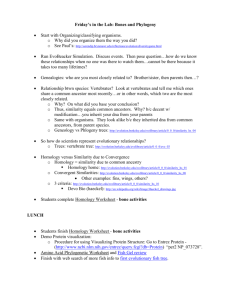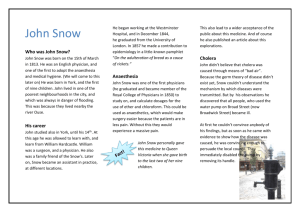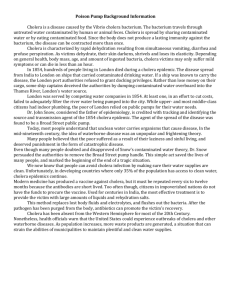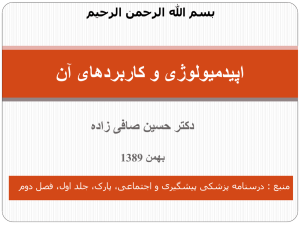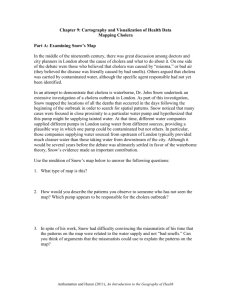Homework 2, due Jan. 20
advertisement
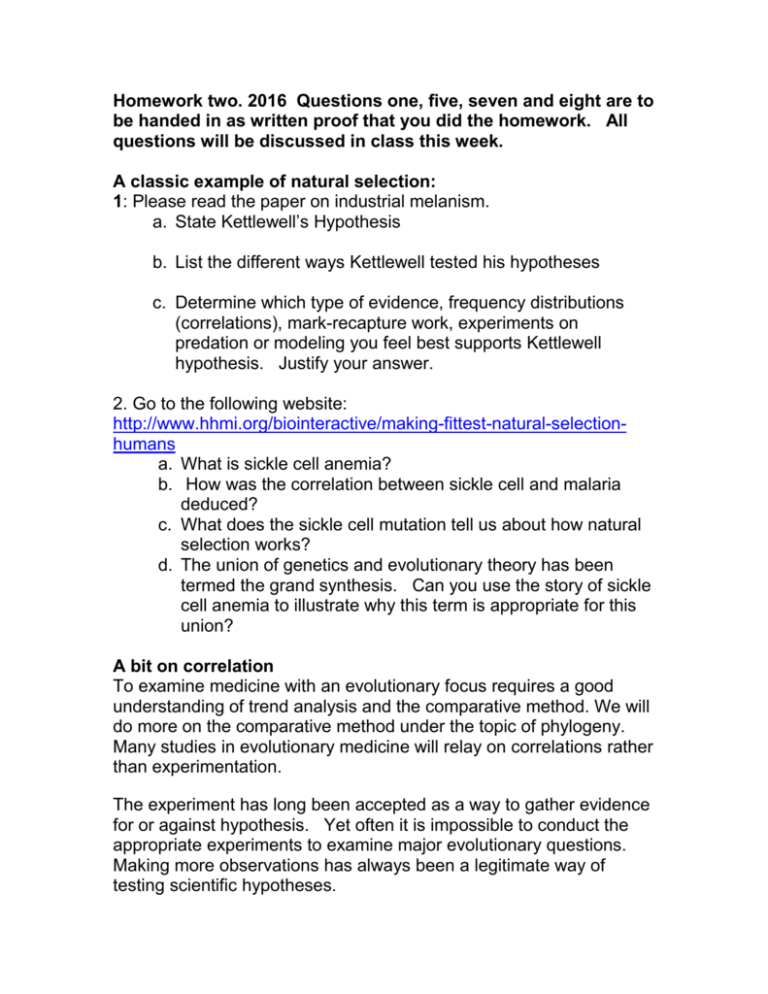
Homework two. 2016 Questions one, five, seven and eight are to be handed in as written proof that you did the homework. All questions will be discussed in class this week. A classic example of natural selection: 1: Please read the paper on industrial melanism. a. State Kettlewell’s Hypothesis b. List the different ways Kettlewell tested his hypotheses c. Determine which type of evidence, frequency distributions (correlations), mark-recapture work, experiments on predation or modeling you feel best supports Kettlewell hypothesis. Justify your answer. 2. Go to the following website: http://www.hhmi.org/biointeractive/making-fittest-natural-selectionhumans a. What is sickle cell anemia? b. How was the correlation between sickle cell and malaria deduced? c. What does the sickle cell mutation tell us about how natural selection works? d. The union of genetics and evolutionary theory has been termed the grand synthesis. Can you use the story of sickle cell anemia to illustrate why this term is appropriate for this union? A bit on correlation To examine medicine with an evolutionary focus requires a good understanding of trend analysis and the comparative method. We will do more on the comparative method under the topic of phylogeny. Many studies in evolutionary medicine will relay on correlations rather than experimentation. The experiment has long been accepted as a way to gather evidence for or against hypothesis. Yet often it is impossible to conduct the appropriate experiments to examine major evolutionary questions. Making more observations has always been a legitimate way of testing scientific hypotheses. Example: Every time the sun sets in the west and rises in the east I am more convinced that it will continue to do so. (reason for the sun rising----http://www.universetoday.com/18117/why-does-the-sun-risein-the-east-and-set-in-the-west/) Correlations are trends, collections of observations, measured by the tightness of fit between two variables. Statistics is often used to determine how closely data points fit to a straight line drawn between them (linear regression). Three relationships with the same slope, but different amounts of “scatter” around an imagined best fit line. Lately non-experimental science has been dubbed discovery science. This seems a humble name for methods that have given use major theories in biology such as "the cell theory" and "the grand synthesis or evolutionary theory". 3. Dr. Snow used observations and correlations to determine the cause of cholera. An observation based on interviews and city medical records. "The most terrible outbreak of cholera which ever occurred in this kingdom, is probably that which took place in Broad Street, Golden Square, and the adjoining streets, a few weeks ago. Within two hundred and fifty yards of the spot where Cambridge Street joins Broad Street, there were upwards of five hundred fatal attacks of cholera in ten days. The mortality in this limited area probably equals any that was ever caused in this country, even by the plague: and it was much more sudden, as the greater number of cases terminated in a few hours. The mortality would undoubtedly have been much greater had it not been for the flight of the population. Persons in furnished lodgings left first, then other lodgers went away, leaving their furniture to be sent for when they could meet with a place to put it in." A correlative map put together by Snow. a. How do you think Snow used observation and mapping to pinpoint the source of cholera. b. Read the following passage from Snow's work. Why did Snow feel it important to investigate individuals in the area of the outbreak that did not get cholera? “There are certain circumstances bearing on the subject of this outbreak of cholera which require to be mentioned. The Workhouse in Poland Street is more than three-fourths surrounded by houses in which deaths from cholera occurred, yet out of five hundred and thirty-five inmates only five died of cholera. . . . The workhouse has a pump-well on the premises, in addition to the supply from the Grand Junction Water Works, and the inmates never sent to Broad Street for water. If the mortality in the workhouse had been equal to that in the streets immediately surrounding it on three sides, upwards of one hundred persons would have died. “ “ There is a Brewery in Broad Street, near to the pump, and on perceiving that no brewer's men were registered as having died of cholera, I called on Mr. Huggins, the proprietor. He informed me that there were above seventy workmen employed in the brewery, and that none of them had suffered from cholera--at least in a severe form--only two having been indisposed, and that not seriously, at the time the disease prevailed. “ “ The men are allowed a certain quantity of malt liquor, and Mr. Huggins believes they do not drink water at all; and he is quite certain that the work-men never obtained water from the pump in the street. There is a deep well in the brewery, in addition to the New River water. “ 4. More recent examples of natural selection in action: a, Examine the examples on this web site. Briefly explain why the first two examples are good examples of natural selection directing the changes observed. http://evolution.berkeley.edu/evolibrary/article/microexamples_01 b. Carl Bergstrom’s work on modeling antibiotic resistance http://evolution.berkeley.edu/evolibrary/article/0_0_0/bergstrom_03 to http://evolution.berkeley.edu/evolibrary/article/0_0_0/bergstrom_05 More on genetic drift: 5. Examine the examples on these two websites. http://evolution.berkeley.edu/evolibrary/article/samplingerror_01 and http://evolution.berkeley.edu/evolibrary/article/bottlenecks_01 Briefly compare founder effects to bottlenecks. 6. Go to following site for Huntington’s chorea. http://evolution.berkeley.edu/evolibrary/article/medicine_05 Why is Huntington’s chorea so prevalent in the lake Maracaibo community? You should consider all evolutionary factors that affect the persistence of this disease. 7. A simulation on genetic drift. Please visit these web pages and answer questions 7a and 7b. 7a http://pages.ucsd.edu/~dkjordan/resources/clarifications/Mitochondria lEve.html and 7b http://www.cals.ncsu.edu/gn/ex/mit-eve.html a. Who is mitochondrial eve? b. Run the simulation 5 times until only one Eve remains. What is the smallest number of generations it took to fix mitochondrial type? What was the longest number of generations it took to fix mitochondrial type? 8, Go to http://evolution.berkeley.edu/evolibrary/news/131211_bottlenecks a. What can evolutionary history tell us about the evolution of the BRCA gene? b. Read an article expression an alternate explanation. You must download it from the web. The link is on the course schedule. Try simply to understand the hypothesis and how the authors tested it. Assume the authors use of statistics is legitimate, although we may ask Dr. Thorne’s opinion of their methods. c. Which explanation in your mind is best supported by the evidence presented?

